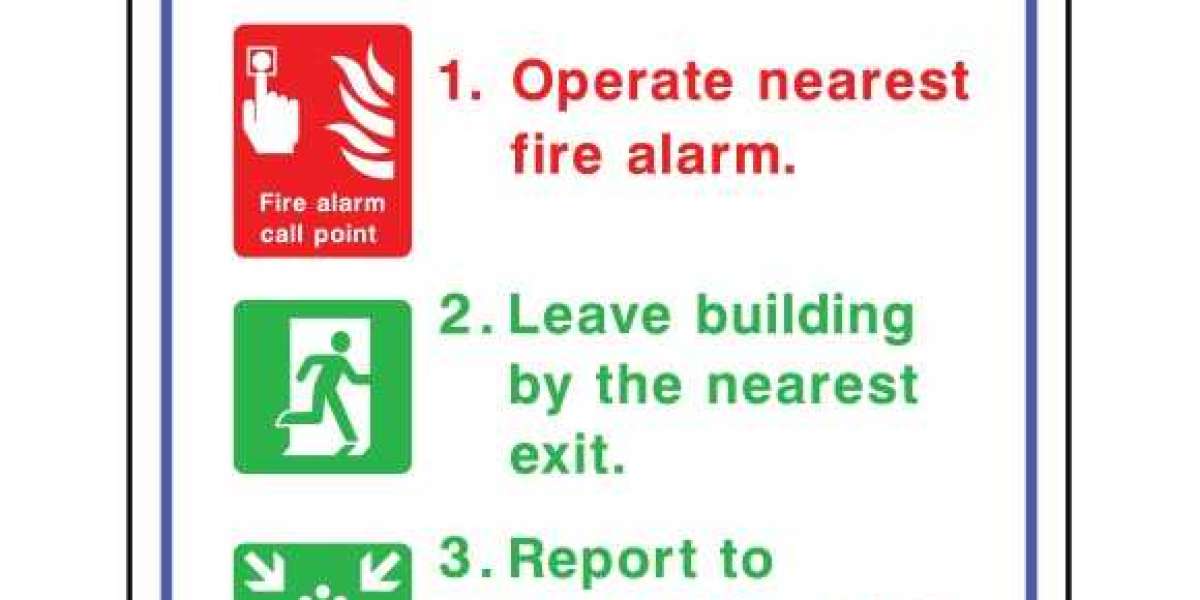When an emergency occurs, every second counts. The speed of response can mean the difference between a safe evacuation and unnecessary risk. In such situations, clear visual communication is essential—and this is where fire signage proves invaluable. From highlighting the location of vital equipment to guiding people towards safe exits, these signs ensure swift, instinctive action. Two of the most important are the fire alarm sign and the fire action signs. While one prompts the alarm to be raised, the other offers clear steps to follow. In this blog, we’ll explore their importance, standards, and design principles for effective safety.
Why Fire Signage Matters
Emergencies often lead to panic, confusion, and disorientation. In a smoke-filled corridor or a crowded office, verbal instructions may go unheard. Fire signage bridges this gap by providing instant, universally recognised directions.
Key reasons why fire signage is essential include:
- Clarity under pressure: People can act quickly without needing additional explanation.
- Universal understanding: Colour coding and symbols transcend language barriers.
- Legal compliance: Safety legislation requires buildings to be fitted with correct signage.
- Confidence: Clear signs help occupants feel reassured about safety measures in place.
Ultimately, fire signage acts as a silent guide, present throughout the building, ready to communicate vital information when needed most.
Fire Alarm Signs – First Line of Action
The fire alarm sign has one crucial purpose: to ensure that everyone knows how and where to activate the alarm system. These signs are usually placed beside manual call points, so that in the event of spotting smoke or fire, a person can raise the alarm immediately.
Common features of fire alarm signs include:
- Red background with white symbols or text – consistent with fire equipment categories.
- Simple iconography – such as a hand pressing a button or bell symbol.
- Positioning – always placed where alarms or call points are installed.
By being instantly recognisable, fire alarm signs eliminate hesitation. They ensure that no one wastes precious seconds trying to figure out how to alert others.
Fire Action Signs – Directing Behaviour
While alarm signs initiate the process, fire action signs provide the next steps. These signs are usually blue and white, representing mandatory instructions. Their role is to clearly outline what individuals should do once the alarm has been raised.
Standard fire action signs often include instructions such as:
- Raise the alarm immediately.
- Call the fire brigade using the nearest phone.
- Leave the building via the designated escape routes.
- Do not use lifts during evacuation.
- Assemble at the designated meeting point.
By providing structured, step-by-step instructions, fire action signs remove uncertainty. In a stressful moment, individuals don’t need to think – they simply follow the visual guide.
Cohesion in Emergency Messaging
Although each type of sign has its own purpose, their real power lies in how they work together. A disjointed approach can cause confusion, while a cohesive system ensures smooth, coordinated behaviour.
Key principles of cohesion include:
- Consistency in design: Using standard symbols, colours, and typefaces across all signs.
- Strategic flow: Alarm signs prompt action, while action signs guide behaviour afterwards.
- Unified visual language: Avoid mixing outdated symbols with modern compliant ones.
Type of Sign | Purpose | Colour Code | Placement |
Fire Alarm Sign | Indicate alarm call points | Red/White | Beside manual alarms, visible in corridors |
Fire Action Sign | Provide step-by-step instructions | Blue/White | Entrances, lobbies, communal areas |
By aligning signage design and placement, building managers create an environment where occupants can instinctively respond without confusion.
Compliance Standards
Fire signage isn’t just good practice – it’s a legal requirement. In the UK, signs must conform to BS 5499 and ISO 7010 standards. These standards dictate the correct use of symbols, colours, and layouts to ensure universal recognition.
Key points of compliance include:
- Red – for fire-fighting equipment and alarms.
- Blue – for mandatory instructions.
- Green – for safe condition and escape routes.
- White symbols – to ensure clarity against bold backgrounds.
Non-compliance can lead not only to fines but also to legal liability in the event of an incident. More importantly, incorrect signage increases the risk of panic or hesitation when every second counts.
Design Considerations for Effective Fire Signage
Beyond compliance, good design ensures signs are visible and practical in real-world conditions. Important considerations include:
- Visibility: Signs should be large enough to be seen at a distance and placed at eye level.
- Contrast: Bold colours and clear icons improve legibility.
- Durability: Weather-resistant materials for outdoor areas; photoluminescent or glow-in-the-dark finishes for low light.
- Accessibility: Symbols that are clear even for those with limited language skills or visual impairments.
- Consistency: Using the same style throughout the building avoids mixed signals.
A poorly designed or faded fire alarm sign could go unnoticed, while a well-placed, high-quality one ensures immediate recognition.
Placement Strategy
Correct placement is as important as design. Even the clearest sign fails if it’s hidden or obscured.
Where to place fire alarm signs:
- Directly above or next to manual alarm call points.
- Along corridors and exit routes to confirm alarm locations.
Where to place fire action signs:
- Near building entrances and lobbies.
- In communal areas such as kitchens, staff rooms, or waiting areas.
- Adjacent to fire alarm call points to provide immediate instructions after activation.
The goal is to ensure that no one ever has to search for instructions – they should always be in plain view.
Future of Fire Signage
While traditional signs remain essential, technology is starting to play a role in emergency communication. LED-based fire signage, digital wayfinding panels, and systems linked directly to alarms are becoming more common. These innovations offer dynamic messaging, guiding people towards the safest exit depending on where the hazard is located.
However, even as technology evolves, the core principle remains unchanged: clear, consistent, and cohesive emergency messaging saves lives.
Conclusion
Fire safety goes far beyond equipment and drills—it relies on clear, visible communication that guides people when it matters most. A properly positioned fire alarm sign, supported by clear fire action instructions, can remove uncertainty and ensure quick, safe responses in emergencies. To achieve this, signage must combine compliance, strong design, and thoughtful placement. For businesses and organisations, reviewing and upgrading existing signage is a vital step towards a safer environment.
At Foamex Printing Company, we provide expertly crafted fire signage solutions that prioritise safety, compliance, and clarity—helping you protect people, property, and peace of mind.














